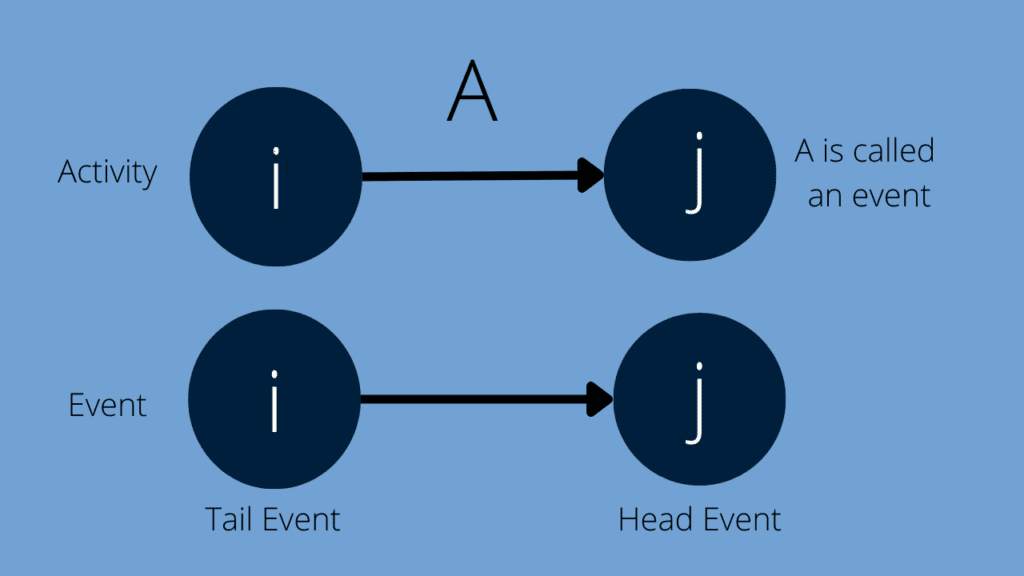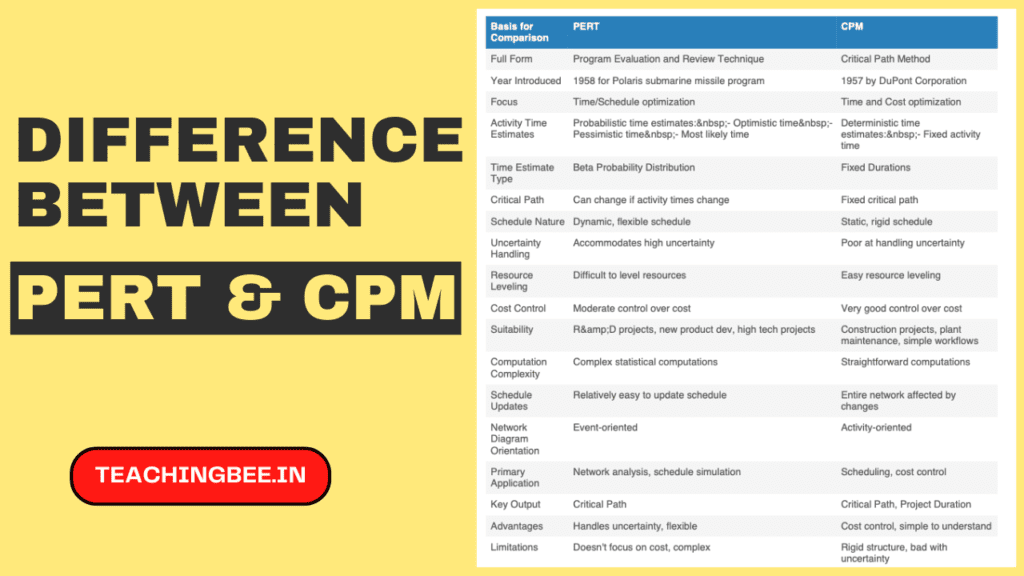Table of Contents
ToggleProject management methodologies like Program Evaluation and Review Technique (PERT) and Critical Path Method (CPM) are widely used for planning, scheduling and monitoring complex projects. Both PERT and CPM are useful project management techniques that help optimize timelines, reduce costs and manage resources efficiently.
This article provides an in-depth look at CPM And PERT methodologies, their key features, similarities and difference between pert and cpm. It examines the advantages and disadvantages of each method and provides guidelines on when each technique is most applicable. Real-world examples demonstrate PERT and CPM usage in different industries. The article also answers common FAQs and summarizes key learnings on selecting and difference between PERT and CPM.
Brief Overview of CPM and PERT
CPM and PERT are project management techniques designed to assist with planning, scheduling, and monitoring of project timelines and milestones.
PERT stands for Program Evaluation and Review Technique. It was developed in the 1950s for the US Navy’s Polaris missile program and is ideally suited for projects with high uncertainty. PERT provides probabilistic time estimates for project activities.
CPM stands for Critical Path Method. It was developed by DuPont in the 1950s for plant maintenance projects. CPM focuses on project timeline optimization by identifying the critical path – the sequence of dependent activities that determines the minimum project duration.
Both CPM And PERT aid complex project execution through activity sequencing, graphical representations of workflows, resource allocation, time estimations, and schedule optimisation. They provide a mathematical basis for activity scheduling and control.
Difference Between PERT And CPM
Let’s explore some PERT And CPM difference. Some key differences between PERT and CPM in detail:
Focus Areas
- PERT focuses on project timeline and scheduling by determining the critical path based on activity durations.
- CPM focuses on both time scheduling and cost optimization by determining the critical path and minimizing overall project cost.
Activity Time Estimates
- PERT uses probabilistic time estimates for each activity – optimistic, most likely and pessimistic duration.
- CPM uses fixed deterministic time estimates for each activity.
Critical Path
- In PERT, the critical path can change if the activity time estimates change.
- In CPM, the critical path is fixed once calculated.
Schedule Flexibility
- PERT allows for a more dynamic and flexible schedule by modifying sequences and time estimates.
- CPM creates a relatively rigid schedule with limited flexibility for changes once finalized.
Uncertainty Handling
- PERT can accommodate high uncertainty in activity durations because of its probabilistic approach.
- CPM is not equipped to handle significant uncertainties in activity times.
Resource Leveling
- Resource leveling is difficult in PERT as activity sequences can change.
- CPM allows easier resource leveling across activities.
Cost Control
- PERT does not explicitly focus on project cost management.
- CPM enables close monitoring and control of costs.
Suitability
- PERT suits projects with high uncertainty like R&D, new product development etc.
- CPM is ideal for routine projects like construction, plant maintenance with predictable activities.
Computation Method
- PERT uses statistical analysis to arrive at expected activity times.
- CPM uses simple deterministic activity time estimates.
Updating Schedules
- PERT schedules are easy to update by changing time estimates.
- CPM schedule changes affect the entire activity network flow.
In summary, main difference between PERT And CPM is that PERT is preferred for uncertain projects while CPM works better where activities are clearly defined and certainty exists around time and cost estimates.
| Basis for Comparison | PERT | CPM |
|---|---|---|
| Full Form | Program Evaluation and Review Technique | Critical Path Method |
| Year Introduced | 1958 for Polaris submarine missile program | 1957 by DuPont Corporation |
| Focus | Time/Schedule optimization | Time and Cost optimization |
| Activity Time Estimates | Probabilistic time estimates: – Optimistic time – Pessimistic time – Most likely time | Deterministic time estimates: – Fixed activity time |
| Time Estimate Type | Beta Probability Distribution | Fixed Durations |
| Critical Path | Can change if activity times change | Fixed critical path |
| Schedule Nature | Dynamic, flexible schedule | Static, rigid schedule |
| Uncertainty Handling | Accommodates high uncertainty | Poor at handling uncertainty |
| Resource Leveling | Difficult to level resources | Easy resource leveling |
| Cost Control | Moderate control over cost | Very good control over cost |
| Suitability | R&D projects, new product dev, high tech projects | Construction projects, plant maintenance, simple workflows |
| Computation Complexity | Complex statistical computations | Straightforward computations |
| Schedule Updates | Relatively easy to update schedule | Entire network affected by changes |
| Network Diagram Orientation | Event-oriented | Activity-oriented |
| Primary Application | Network analysis, schedule simulation | Scheduling, cost control |
| Key Output | Critical Path | Critical Path, Project Duration |
| Advantages | Handles uncertainty, flexible | Cost control, simple to understand |
| Limitations | Doesn’t focus on cost, complex | Rigid structure, bad with uncertainty |
Importance in Project Management
PERT and CPM enable optimised project planning by:
- Identifying interdependencies between project activities.
- Sequencing activities in the most efficient order.
- Estimating reasonable timelines for project completion.
- Allocating resources effectively across critical activities.
- Continuously monitoring progress to avoid delays.
- Updating schedules based on changing project dynamics.
- Optimising time-cost tradeoffs to meet deadlines and budgets.
- Simulating impacts of changes in activities on overall project timeline.
- Presenting project information visually through diagrams.
What is PERT?
Definition
PERT stands for Program Evaluation and Review Technique. It is a project management methodology mainly used for projects with high levels of uncertainty in activity completion times. PERT utilises probabilistic time estimates for activities instead of fixed time estimates.
Key Features
The key features of PERT are:
- Models projects as a network diagram containing numbered nodes signifying events/milestones and arrows denoting activities.
- Assigns optimistic, pessimistic and most likely time estimates for each activity.
- Calculates expected activity duration using the beta probability distribution formula based on the three time estimates.
- Determines critical path – the sequence of dependent activities with the highest total expected time.
- Enables simulation of project completion time based on activity time variations.
- Used for projects with significant uncertainty around activity time estimates.
Use Cases
PERT is best suited for projects where the individual activity completion times are uncertain such as:
- Research and development projects
- New product development with unproven technologies
- Projects using new construction techniques
- Highly complex IT systems and infrastructure projects
What is CPM?
Definition
CPM stands for Critical Path Method. It is a project management technique used for scheduling project activities to optimize the overall project timeline. CPM focuses on identifying the longest path of dependent activities that directly impacts project completion.
Key Features
The key features of CPM are:
- Models projects as network diagrams with numbered nodes for events and arrows for activities.
- Assigns fixed time estimates for completion of each activity.
- Determines the critical path – the chain of activities with the highest total duration.
- Calculates minimum completion time for the project based on critical path length.
- Enables tradeoff analysis between project timeline and cost.
- Used for projects with reasonable certainty in activity time estimates.
Use Cases
CPM is suitable for projects where activity durations can be accurately estimated such as:
- Construction projects
- Plant maintenance projects
- Software product development projects
- Relatively routine IT systems implementation
The components of the CPM and PERT network
Activities – Activities represent the actual work or tasks that need to be performed in a project. Activities have a definite duration and require resources like labor, materials, etc.
Events – Events represent the start or completion of one or more activities. They signify milestones or landmarks in the project. An event occurs at a specific point in time and marks the transition from one activity to another.
Activity Relationships – Activities in a project are interrelated and dependent on each other. These relationships are shown in the network diagram using arrows to indicate the sequence of activities. Common relationships include finish-to-start, start-to-start, finish-to-finish, etc.
Activity Duration – The time required to complete an activity is known as its duration. Activity durations are estimated based on resources and effort required. Duration is depicted on the network diagram.
Critical Path – The critical path is the longest sequence of dependent activities that determines the minimum time required to complete the project. Activities on the critical path have zero slack or float.
Slack or Float – Slack or float represents the amount of time an activity can be delayed without affecting the overall project completion time. It is the difference between the earliest and latest start/finish times of an activity.


Similarities Between PERT and CPM
Despite some difference between PERT And CPM , they share some common features in terms of project modelling, analysis and management:
Planning and Scheduling
Both CPM And PERT provide activity-based project network models for planning and scheduling workflows. Activities are sequenced from start to finish while considering dependencies between activities. Gantt charts can be derived from PERT and CPM diagrams to view project timelines.
Graphical Representations
CPM And PERT use activity-on-arrow diagrams to pictorially represent a project. Nodes indicate events while arrows denote activities. These network diagrams enable visualization of the planned workflow.
Advantages and Disadvantages
Pros and Cons of PERT:
Advantages:
- Suits projects with high uncertainty.
- Probabilistic estimates provide realistic timelines.
- Critical path can be recalculated as uncertainties reduce.
- Useful for research projects with unpredictable activities.
Disadvantages:
- Computationally intensive.
- Requires expertise to derive beta distributions for estimates.
- Less suited for routine projects.
Pros and Cons of CPM:
Advantages:
- Simple activity time estimates.
- Optimal resource utilisation and cost control.
- Critical path is fixed providing execution stability.
- Easy schedule monitoring using float times.
Disadvantages:
- Unsuited for highly uncertain, first-of-a-kind projects.
- Limited flexibility to change activity sequences.
- Does not easily accommodate unplanned delays.
Real-world Examples
PERT in R&D
The Polaris missile program which pioneered PERT is an apt example of its use in research projects. Deploying the submarine-launched ballistic missile involved advanced technological research activities with high uncertainty. PERT’s probabilistic approach allowed for this uncertainty to create a realistic schedule.
CPM in Construction
Construction projects involve numerous interdependent activities with predictable durations, making them ideal for CPM. CPM enables contractors to optimize activity sequences, resource usage and overall project timelines for construction projects.
How to Choose Between CPM And PERT
Choosing between CPM And PERT depends on various factors:
Decision Factors
The suitability of PERT vs CPM depends on:
- Project complexity and uncertainty
- Availability of activity time/cost data
- Resource constraints
- Need for schedule flexibility
- Ability to precisely define activities upfront
Industry Recommendations
- PERT suits R&D projects, highly complex IT systems, new product development.
- CPM common in construction projects, plant maintenance, routine IT deployments.
- Software projects can use either PERT or CPM tailored to specific needs.
There is no universal rule. Project managers need to assess their specific project environment and requirements to determine if PERT or CPM is a better fit. Using elements of both in a hybrid approach is also an option.
Conclusion
Summary
CPM And PERT offer activity-based network modelling for optimised project scheduling. PERT uses probabilistic estimates while CPM uses fixed duration estimates. While both share common features like graphical scheduling, PERT is suited for uncertain projects and provides more flexibility. CPM works best for routine projects by defining the critical path to control costs.
Final Thoughts
CPM And PERT should be selected based on project characteristics like uncertainty, flexibility needs and resource considerations. These quantitative techniques provide structured approaches for project planning and execution. Using PERT/CPM ensures projects have a mathematically computed basis for scheduling as opposed to intuitive guesswork, enabling better management of time, cost and quality.
Try out our free resume checker service where our Industry Experts will help you by providing resume score based on the key criteria that recruiters and hiring managers are looking for.
FAQs
Q. Is PERT or CPM better?
Neither technique is inherently better. PERT suits highly uncertain projects while CPM suits routine projects with predictable activities.
Q. What is the main difference between PERT and CPM?
The main difference is PERT uses probabilistic time estimates while CPM uses fixed time estimates. PERT is more flexible as the critical path can change.
Q. Can PERT and CPM be used together?
Yes, CPM And PERT can complement each other if used together for a project. CPM could provide the overall structure, while PERT is used for uncertain sub-projects.
Q. Which technique was developed first – PERT or CPM?
PERT was developed first in the 1950s for the Polaris submarine missile program. CPM was developed shortly after also in the 1950s by DuPont.
Q. Is PERT a statistical technique?
Yes, PERT uses statistical analysis, specifically beta probability distributions, to calculate the expected time for activities based on three-point estimates.
References
- CPM – Critical Path Analysis Explained (projectmanager.com)
- Critical Path Method Example | Top 3 Examples of CPM (project-management-skills.com)
- Program evaluation and review technique – Wikipedia (wikipedia.org)
- Finding the Critical Path | PERT Charts | Smartsheet (smartsheet.com)
- PERT vs CPM: What’s the Difference & How to Choose (workzone.com)
- PERT Definition, Advantages and Disadvantages (project-management-skills.com)




